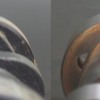Compared to a flat tappet street cam, a roller street cam designed for a similar powerband opens the valves more quickly, lifts the valves further off their seats, holds the valves at maximum lift longer, and then closes the valves more quickly.
Hydraulic roller cams tend to float the valves at a lower rpm compared to the hydraulic flat tappet grinds. Although the weight of the roller lifter is a factor in this, the more agressive ramps are also a contributing factor. Either set up will require a good roller rocker, a heavy wall push rod and the recommended valve springs. Its just a little more necessary with the roller cam.
Also be aware there are two styles of hydraulic roller lifter: the Ford style that uses dog bones and a spyder to orient the lifters; or the Crane style that uses a link bar. The Crane style lifter has a much higher rpm capability.
If a knowlegable motor builder like MME is selling you the parts, you shall have no problems with valve float at an early rpm.
If its in the budget, the roller cam is highly recommended. You'll make more bhp and reduce frictional losses. The worry about zddp in motor oil becomes a moot point.
Look at the photo below, you can see with the naked eye the difference in lobe profile between the two cams, even though both cams have very similar specs. The flat tappet cam lobe is more "pointed", the roller cam lobe is more blunt, because it holds the valve open at maximum lift longer.
PANTERA INTERNATIONAL
A DE TOMASO CAR CLUB
Presents the De Tomaso Forums
The On-Line Meeting Place for De Tomaso Owners and Enthusiasts From Around the World
Clicking on the banner will take you to the sponsor's website.


